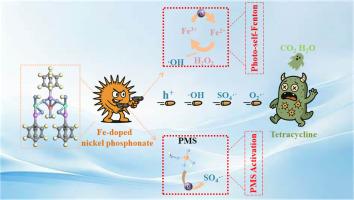Boosting tetracycline degradation via synergistic photo-self-Fenton/peroxymonosulfate activation using sea-urchin-like iron-doped nickel phosphonate catalysts
IF 6.3
3区 工程技术
Q1 ENGINEERING, CHEMICAL
Journal of the Taiwan Institute of Chemical Engineers
Pub Date : 2025-07-29
DOI:10.1016/j.jtice.2025.106311
引用次数: 0
Abstract
Background
Transition metal phosphonates have demonstrated significant potential in catalysis due to their versatile coordination configurations and tunable structural frameworks. However, their direct application in photo-self-Fenton and peroxymonosulfate activation systems for organic pollutant degradation has rarely been explored.
Methods
In this study, a novel three-dimensional (3D) sea-urchin-like iron-doped nickel phosphonate (NiFeP2) was synthesized and employed as a catalyst in a photo-self-Fenton system for the efficient degradation of tetracycline (TC). Characterization revealed that the hierarchical architecture of NiFeP2 not only enhances light absorption and exposes abundant active sites but also facilitates synergistic peroxymonosulfate activation and photo-self-Fenton reactions, thereby improving catalytic performance.
Significant findings
Under optimized conditions, NiFeP2 achieved an apparent reaction rate constant (kobs) of 0.0589 min⁻¹ for TC degradation, demonstrating superior pollutant removal efficiency. The synthesized NiFeP2 photocatalyst exhibited excellent recyclability and maintained stable photocatalytic performance over multiple cycles, demonstrating its promising suitability for real-world wastewater purification applications. This work presents an effective photo-self-Fenton system based on NiFeP2, offering a promising strategy for the remediation of refractory organic pollutants in wastewater treatment.

海胆样铁掺杂磷酸镍催化剂光自fenton /过氧单硫酸盐协同活化促进四环素降解
过渡金属膦酸盐由于其多样的配位构型和可调的结构框架,在催化方面显示出巨大的潜力。然而,将其直接应用于光自fenton和过氧单硫酸盐活化体系中降解有机污染物的研究却很少。方法合成了一种新型的三维(3D)海胆状铁掺杂磷酸镍(NiFeP2),并在光自fenton系统中作为催化剂高效降解四环素(TC)。表征表明,NiFeP2的层次化结构不仅增强了光吸收,暴露了丰富的活性位点,还促进了过氧单硫酸盐的协同活化和光自fenton反应,从而提高了催化性能。在优化的条件下,NiFeP2对TC的表观反应速率常数(kobs)为0.0589 min⁻¹,表现出优异的污染物去除效率。合成的NiFeP2光催化剂具有良好的可回收性,并在多次循环中保持稳定的光催化性能,证明了其在实际废水净化应用中的良好适用性。本研究提出了一种有效的基于NiFeP2的光自fenton系统,为废水处理中难降解有机污染物的修复提供了一种有前景的策略。
本文章由计算机程序翻译,如有差异,请以英文原文为准。
求助全文
约1分钟内获得全文
求助全文
来源期刊
CiteScore
9.10
自引率
14.00%
发文量
362
审稿时长
35 days
期刊介绍:
Journal of the Taiwan Institute of Chemical Engineers (formerly known as Journal of the Chinese Institute of Chemical Engineers) publishes original works, from fundamental principles to practical applications, in the broad field of chemical engineering with special focus on three aspects: Chemical and Biomolecular Science and Technology, Energy and Environmental Science and Technology, and Materials Science and Technology. Authors should choose for their manuscript an appropriate aspect section and a few related classifications when submitting to the journal online.

 求助内容:
求助内容: 应助结果提醒方式:
应助结果提醒方式:


